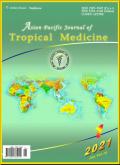根除淋巴丝虫病:我们目前的进展如何?
IF 1.6
4区 医学
Q3 PUBLIC, ENVIRONMENTAL & OCCUPATIONAL HEALTH
引用次数: 1
摘要
淋巴丝虫病(LF)是人类的一种无症状、急性和慢性疾病,是仅次于疟疾的第二常见媒介传播疾病。根据世界卫生组织的数据,在81个热带和亚热带国家发现了1.2亿LF病例,10亿人面临风险。因此,消除淋巴丝虫病全球计划于2000年启动,其主要目标是通过大规模药物管理(MDA)阻止LF在所有高危人群中的传播,控制疾病,并通过最低限度的治疗方案预防LF相关损伤。此外,包括国家丝虫病控制计划和世界卫生组织在内的流行病学评估等其他项目也建议进行常规和MDA前微丝血症调查,以阻止LF传播。全年每月对约2000至4000人进行常规丝虫病调查,而MDA前调查每年也在四个固定和四个随机地点对约4000人进行。此外,还进行了传播评估调查,以检查小学生患LF的风险。此外,潜在的诊断方法、系统的监测制度、直接网络报告系统以及定期培训和意识也可能有效预防LF的复发。因此,本次审查强调了潜在的宣传工具和各种战略以及监测程序,这可能对消除LF产生影响。本文章由计算机程序翻译,如有差异,请以英文原文为准。
Eradication of Lymphatic Filariasis: Where we stand so far?
Lymphatic filariasis (LF), an asymptomatic, acute, and chronic condition in human beings, is the second most common vector-borne disease after malaria. According to the World Health Organization, there are 120 million LF cases detected in 81 tropical and subtropical countries, and one billion people are at risk. Therefore, the Global Program to Eliminate Lymphatic Filariasis was launched in 2000, with the primary objective of stopping LF transmission among all at-risk groups using mass drug administration (MDA), managing morbidities, and preventing LF-related impairments using a minimum treatment package. Additionally, other programs such as epidemiological assessment including National Filaria Control Program and World Health Organization recommended routine and pre-MDA microfilaremia surveys also implemented to stop the LF transmission. The routine filaria surveys were also carried out in around 2 000-4 000 individuals/month throughout the year whereas pre-MDA surveys were also conducted every year in approximately 4 000 individuals in four fixed and four random sites. Furthermore, the Transmission Assessment Survey was also conducted to check the risk of LF among primary school children. Moreover, potential diagnostic methods, systematic surveillance regimes, the Direct Network Report system, and regular trainings and awareness may be also effective in preventing the recurrence of LF. Hence, this review emphasizes the potential advocacy tools and various strategies as well as procedures for monitoring, which could be impactful in eliminating LF.
求助全文
通过发布文献求助,成功后即可免费获取论文全文。
去求助
来源期刊

Asian Pacific journal of tropical medicine
PUBLIC, ENVIRONMENTAL & OCCUPATIONAL HEALTH-TROPICAL MEDICINE
CiteScore
4.00
自引率
9.70%
发文量
1936
审稿时长
3-8 weeks
期刊介绍:
Asian Pacific Journal of Tropical Medicine (ISSN 1995-7645 CODEN: APJTB6), a publication of Editorial office of Hainan Medical University,is a peer-reviewed print + online Monthly journal. The journal''s full text is available online at http://www.apjtm.org/. The journal allows free access (Open Access) to its contents and permits authors to self-archive final accepted version of the articles on any OAI-compliant institutional / subject-based repository.
APJTM aims to provide an academic communicating platform for international physicians, medical scientists, allied health scientists and public health workers, especially those of the Asia-Pacific region and worldwide on tropical medicine, infectious diseases and public health, and to meet the growing challenges of understanding, preventing and controlling the dramatic global emergence and re-emergence of infectious diseases in the Asia-Pacific.
The journal is proud to have an international and diverse editorial board that will assist and facilitate the publication of articles that reflect a global view on tropical medicine, infectious diseases and public health, as well as emphasizing our focus on supporting the needs of public health practitioners. The APJTM will allow us to seek opportunities to work with others who share our aim, and to enhance our work through partnership, and to uphold the standards of our profession and contribute to its advancement.
 求助内容:
求助内容: 应助结果提醒方式:
应助结果提醒方式:


